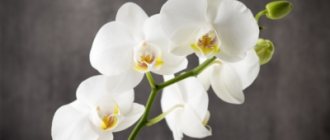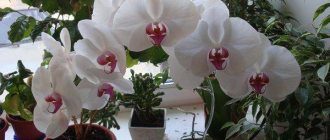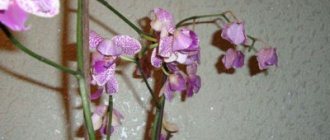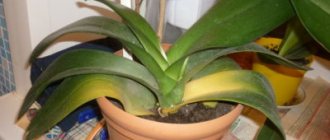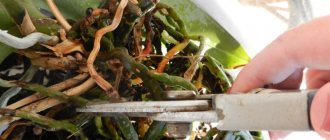Indoor orchids can bloom all year round. But even unpretentious phalaenopsis still have pauses in flowering sooner or later. If the care is correct, you won’t have to wait long for the growth of flower stalks and the appearance of new buds. But even after the buds begin to grow, flowering is not at all guaranteed. At the budding stage, orchids are extremely sensitive and can shed long-awaited buds in a matter of days. And too unexpected falling of flowers is not at all uncommon. The reason for the dropping of orchid buds is always the same - improper maintenance conditions and care. And it is much easier to prevent them than to overcome disappointment from the consequences.
Why does an orchid shed flowers and buds?
Different reasons - one problem
Dropping buds and flowers in orchids is a natural defensive reaction, indicating stress factors or a lack of resources. No matter how much disappointment the sight of yellowing and falling buds brings, it should not be considered a tragedy. One of the most obvious signs and signals will help you quickly identify the problem and solve it in a timely manner.
There are dozens of reasons why orchids may lose buds or already blooming flowers. And almost always this phenomenon is associated with “emergency” factors - a change or selection of conditions and factors of care. With one exception: weakened and old plants shed flowers for completely natural reasons.
To discover the source of problems, it is enough to ask yourself 6 basic questions:
- Have the orchids' placement and conditions changed in recent weeks?
- What condition is the substrate in and is it and the container suitable for orchids?
- Are the lighting and temperature appropriate?
- Is watering carried out correctly and how dry is the air?
- Are fertilizing standards observed?
- Are there any signs of pest or disease damage?
It is the answers to these questions that will suggest not only the possible “culprit” in dropping the buds, but also the next steps. No matter what stage of budding and flowering the orchid is at, you need to respond to such a signal as quickly as possible and without panic.
What can speed up the process of buds withering?
A reduction in flowering time and rapid natural wilting of buds may depend on the age of the orchid. Older plants will have buds that quickly wither. In plants of active age, accelerated wilting of buds can occur when:
- Moving a flower pot from its usual place.
- Insufficient lighting.
- Sudden temperature fluctuations.
- Close location to heating radiators in winter.
- Violation of the watering schedule.
- Excessive or low air humidity.
- Pollination of flowers by insects flying in from the street.
- Exposure to ethylene emanating from ripe bananas, apples lying next to an orchid.
Pests and diseases
As with any indoor plant, at the first sign of problems, you should immediately exclude the most dangerous factors that require drastic measures - infestation with pests or diseases. A careful examination of the plant itself, all the leaves, roots, buds will help you find traces of mealybugs, rot, etc.
If there is the slightest suspicion, the plant must be immediately isolated and measures taken - from washing and biological agents, the use of insecticides and fungicides to emergency replanting with pruning of damaged roots.
If there is the slightest suspicion of infection, the orchid should be immediately isolated and measures taken
Relocation and relocation
Not a single orchid at the flowering stage likes changing conditions, even moving from one place to another on the same windowsill or turning in relation to the light source. Stability is the main secret of long-term flowering of any orchid. And if it is not there, the plant’s first reaction to sudden changes is to drop its buds. Even more stressful is transporting a blooming orchid from a flower shop to an “unfamiliar” house or to rooms with different functionality.
No matter how much the transition is softened, the plant will still notice it. This is a natural process of adaptation that requires non-intervention, rather than transplanting, looking for a new place and further aggravating the problem. All you need is time and patience: once the plant gets used to it, the whole process of development and the next flowering will proceed as it should.
Soil problems
Orchids require a special substrate. But even when choosing a special soil for orchids, consisting mainly of large fragments of bark, it is worth remembering that without regular replanting, such a substrate will sooner or later deplete and deteriorate.
If other causes have been ruled out, immediately check the soil for signs:
- seals, insufficient air permeability;
- traces of mold and rot both on fragments of bark and on the walls of the container.
If replanting has not been carried out for more than 3-4 years, the mass of roots has almost completely hidden the substrate, then the orchid may drop its buds due to depletion and lack of soil.
Be sure to make sure that the plant has enough air: whether the holes for its circulation are closed, whether the container is suitable for growing, because even phalaenopsis will not grow in any pot that comes to hand.
To prevent the special substrate for orchids from becoming depleted and deteriorating, they need to be replanted regularly
How to stop falling
If your home orchid is less than 7 years old, then the reason for the buds falling off is definitely not due to natural aging, but to certain factors that were listed above.
If your orchid blooms in winter, think in advance about how you will provide it with light. Place the pot on the sunniest windowsill, but away from heating devices (they dry out the air). In cloudy weather, illuminate the plant with lamps 3-4 hours a day.
Always control the humidity in the room. During the heating season and summer, spray water around the plant from a spray bottle. In the summer, remove the flower from the windowsill and water it promptly. You cannot overwater the orchid - the frequency of watering should be such that the substrate has time to dry completely between them. This will prevent root rotting.
And remember one important rule: you cannot rearrange orchids during flowering or turn the pot relative to the light source. This is a real stress for them. It is better to immediately choose a place where the flower will be comfortable - not cold and not hot. If you manage to please your pet, she will delight you with long and lush flowering.
Similar articles
Why did the orchid flowers suddenly begin to fade and what to do?
How to water an orchid during flowering
An important operation or how to prune an orchid
Whimsical beauty or Vanda orchid
Lack of light and extreme temperatures
During budding and flowering, orchids of any type need more light than during other phases of development. And consistency of light is the key to their continued flowering. In autumn and winter, if the plant was not moved to a lighter windowsill or measures were not taken to provide additional lighting, the dropping of buds can be considered a natural reaction to a lack of light. And if they were moved - to direct sun.
Orchids that love low temperatures at night do not react to minor temperature deviations. But if the plant is in a draft or experiences a temperature shock - it finds itself in extreme cold, or vice versa, next to heating devices - problems cannot be avoided. Any sudden changes are contraindicated already at the stage of peduncle development, and even more so at budding. Dropping buds is the first of the reactions.
In both cases, it is necessary to adjust the conditions to preserve the remaining buds and normal development until the next budding.
Features of flowering
The orchid begins to bloom at the age of 1.5-2 years, when 5-8 leaves have formed on the stem.
Flowering too early is undesirable: it will be difficult for the plant to regain its strength and it may die.
An orchid can bloom profusely for up to 7 years. After this, flowering is reduced to 1-2 months, and it cannot be extended despite careful care. In this case, plant rejuvenation is required.
There are several phases in the development of an orchid:
- The growing season begins with the formation of a new shoot - leaves and root systems grow.
- During the dormant period, new buds and peduncles are formed.
- During the flowering phase, the plant expends energy.
- This is followed by a period of rest, recuperation and accumulation of energy for new flowering.
Typically the flowering phase lasts about three months and begins in the fall. With proper maintenance, a strong plant can produce flowering shoots even in the spring, having time to replenish its strength. Peduncles can appear three times a year. With quality care, orchids can bloom for more than 8 months.
Excessive watering
Orchids at the flowering stage prefer reduced watering. Even a long delay in subsequent watering rarely causes the buds to drop (although it may affect the overall duration of flowering). Any excessive, too frequent watering not only increases the risk of plant loss from rot, but also causes disturbances in growth and development, which also affects the dropping of buds.
Even such hardy orchids as phalaenopsis, which feel great in living rooms, do not tolerate too dry air during budding and flowering, dropping their buds. The operation of heating systems for them must be compensated for at least by spraying.
The operation of heating systems for hardy orchids must be compensated for at least by spraying
Preventive measures
Careful adherence to the following care rules helps to extend the flowering period and prevent the plant from dropping buds:
- timely watering with settled water +30…+35 degrees;
- fertilizing with phosphorus-potassium fertilizers from the beginning of bud formation until the end of flowering;
- maintaining an optimal level of humidity in the room;
- compliance with temperature conditions.
Careful care and careful handling of the plant will provide it with comfortable conditions. An orchid, if all recommendations are followed, will delight the owner with lush, long-lasting flowering from 2 to 6 months.
5/5 — (1 vote)
Old and weakened orchids
Orchids bring joy for many years, and it would seem that the only sign of their aging is an increase in size. But orchids are also aging, especially the varieties that stimulate the holidays in flower centers. The maximum age of indoor orchids is from 7 to 12 years. They can begin to lose the ability to bloom as early as five years of age.
Even if an orchid has been tirelessly pleasing for almost a dozen years, sooner or later there will come a time when the old plant will not be able to bloom with the same success. The inability to “hold” formed buds and flowers on old plants is a natural process. And usually it is preceded by the formation of children - on the shoots or at the rosette, with which the old plant can be replaced.
If in previous months the orchid suffered from improper care or maintenance conditions, or was weakened for some objective reasons (fall, careless handling, etc.), the plant will not necessarily recover without releasing flower stalks. Rather, on the contrary: affected by stress factors, orchids often quickly produce flower stalks - sometimes several at a time.
But weakened plants simply do not have enough strength to produce all the buds. And the shedding of part of the ovaries or their drying out is a completely natural reaction. The process of “saving energy” is especially noticeable if the orchid has suffered from sunburn and has not been replanted for a long time, when there is not enough space for the development of roots.
Flower processing options
One of the main reasons that an orchid can shed unopened buds is various diseases that appear as spots and bumps on the leaves: they can turn yellow and dry out. It is possible to combat them by treating flowers to prevent the development of pathologies and the proliferation of parasites on them.
Illumination of orchids with lamps
There are many types of pest treatment products on sale, both special chemicals (including numerous fungicides against fungal infections) and biological products and organic compounds. In addition, you can use centuries-old folk floriculture experience.
Chemicals
These are means of rapid and very effective response. They are divided into 4 hazard classes, they must be used strictly for their intended purpose and be sure to follow the dosage, otherwise you can harm both yourself and your green pet. The most popular among orchid lovers are such preparations as:
- "Fitoverm";
- "Inta-Vir";
- "Aktara";
- "Tanrek";
- "Confidor".
More effective, but also more toxic are Actellik, Karbofos, Vertimek.
"Fitoverm" - a chemical preparation for treating orchids
The fungicide “Fitosporin” works well against fungal infections of orchids, which can also be used for prevention during plant replanting and subsequent pruning.
Along with chemical agents, biological flower protection products are produced. Plants do not accumulate them, and pests do not develop resistance. In addition, biological agents serve to increase immunity in orchids. Flower growers recommend fast-acting drugs:
- "Bikol";
- "Bitoxibacillin";
- "Lepidocide";
- "Verticillin";
- "Aversectin S";
- "Nemabact."
"Lepidotsid" - a biological product for treating flowers
Folk remedies
If you don’t want to resort to chemistry, you can stick to folk remedies for treating flowers:
Soap solution: from 1 liter of water and 1 tbsp. spoons of liquid soap (or grated laundry soap), which is used to wipe the stems and foliage.
Additional Information. Regular dishwashing detergent will also work.
- Tobacco tincture: for 1 liter of water, take up to 40 grams of tobacco, ground into dust, leave for 24 hours, then strain and spray Phalaenopsis from a spray bottle.
- An infusion of onion, mashed and poured with 1 liter of boiling water, leave for 7 hours and apply to the leaves and stem. The course is 3-4 days, you should not get carried away, otherwise the plant may dry out.
- Dried citrus peels (100 grams) are poured with a liter of water and infused for a couple of days; the diseased plant is sprayed with this infusion every few hours for a week. Dry orange and tangerine peels can be used to cover the soil in a pot.
- The well-known hydrogen peroxide is used to treat orchids and other indoor plants in order to disinfect foliage and substrate from germs, mites and pests.
Advice
When using this drug, moderation and caution should be observed, otherwise the plant will begin to wither before our eyes.
